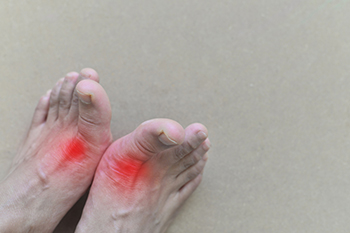Items filtered by date: April 2023
Are You Suffering From Ingrown Toenails?
Stress Fractures and Exercises

Stress fractures can occur in the bones of the feet when tiny cracks develop over an extended period due to repetitive force. When determining if a person is able to engage in exercise when recovering from a stress fracture, a medical professional will have to assess the particular circumstances of the individual’s unique case. If the stress fracture is not too severe, your medical professional might suggest engaging in a range of motion exercise. These specific exercises can improve mobility in the foot and ankle region. They should also not cause the patient any pain. Alternatively, someone recovering from a stress fracture might be able to engage in strengthening exercises to rebuild strength in the muscles of the feet. If you are suffering from a stress fracture in the feet, it is recommended that you contact a podiatrist today for treatment and advice.
Activities where too much pressure is put on the feet can cause stress fractures. To learn more, contact Charles Perry, DPM from Ohio. Our doctor can provide the care you need to keep your pain free and on your feet.
Dealing with Stress Fractures of the Foot and Ankle
Stress fractures occur in the foot and ankle when muscles in these areas weaken from too much or too little use. The feet and ankles then lose support when walking or running from the impact of the ground. Since there is no protection, the bones receive the full impact of each step. Stress on the feet can cause cracks to form in the bones, thus creating stress fractures.
What Are Stress Fractures?
Stress fractures occur frequently in individuals whose daily activities cause great impact on the feet and ankles. Stress factors are most common among:
- Runners
- People affected with Osteoporosis
- Tennis or basketball players
- Gymnasts
- High impact workouts
Symptoms
Pain from the fractures occur in the area of the fractures and can be constant or intermittent. It will often cause sharp or dull pain with swelling and tenderness. Engaging in any kind of activity which involves high impact will aggravate pain.
If you have any questions please feel free to contact our offices located in Cambridge and Zanesville, OH . We offer the newest diagnostic and treatment technologies for all your foot and ankle needs.
Foot and Other Health Problems From Working on the Feet

It is a well known fact that working on the feet all day and having to stand for prolonged periods of time can have negative health consequences for your feet. For example, if your job requires you to stand all day, you may be setting yourself up for an increased risk of experiencing foot pain, or possibly developing foot conditions like plantar fasciitis. In addition, standing on the feet all day may result in swollen feet or ankles. However, the negative health consequences of standing all day are not limited to the feet. Namely, an individual may also develop chronic back pain and neck or shoulder stiffness. Further, one’s risk of experiencing heart disease may possibly increase. If you are someone who must stand for prolonged periods of time, it is recommended that you contact a podiatrist today.
While working on the feet, it is important to take the proper care of them. For more information about working on your feet, contact Charles Perry, DPM from Ohio. Our doctor will treat your foot and ankle needs.
Working on Your Feet
Standing on your feet for long periods of time can cause stress and pain in your feet. Your whole body may experience change in terms of posture, back pain, bunions, callouses and or plantar warts. There are ways to avoid these conditions with proper foot care, smart choices and correct posture.
Positive Changes
Negative heeled shoe – Choosing this shoe type places the heel slightly lower than the ball of the foot. These are great for overall foot health. Find shoes that fit you correctly.
Go barefoot – Our feet were not designed to be enclosed for all hours of the day. Try to periodically expose your feet to air.
Eliminate Pain
Foot Exercises – Performing simple exercises, incorporating yoga and doing stretches are beneficial. This will allow increased blood flow to the area and muscles of the foot.
Achilles tendon – Stretching the foot out flat on the floor will relax the calf muscles and tendon. These exercises can be performed almost anywhere. Make sure you add these exercises to your daily regimen.
With a little bit of this information and knowing more about foot health, you will notice changes. Foot stretches and proper footwear will help with pain and prevent further issues.
If you have any questions please feel free to contact our offices located in Cambridge and Zanesville, OH . We offer the newest diagnostic and treatment technologies for all your foot and ankle needs.
Painful Gout

Having high levels of uric acid in the blood may lead to developing a condition that is known as gout. It is a form of arthritis, and it can cause debilitating pain and discomfort. The affected toe can be swollen and red, and may consistently ache. Excess uric acid can happen from foods that are eaten that contain purines. These types of foods can include shellfish, red meat, and drinks that are made with large amounts of sugar. Gout generally affects the big toe, where the uric acid converts to crystals that lodge in the joints of the big toe. Effective prevention methods can consist of eating healthy foods and beginning a gentle exercise program. People who are overweight, have diabetes, or chronic kidney disease may be prone to experiencing gout attacks. Additionally, having high blood pressure or thyroid disease may also lead to developing gout. Many people can have one or multiple gout attacks. If this applies to you, it is suggested that you consult with a podiatrist who can guide you toward effective prevention methods and relief options.
Gout is a painful condition that can be treated. If you are seeking treatment, contact Charles Perry, DPM from Ohio. Our doctor will treat your foot and ankle needs.
What Is Gout?
Gout is a form of arthritis that is characterized by sudden, severe attacks of pain, redness, and tenderness in the joints. The condition usually affects the joint at the base of the big toe. A gout attack can occur at any random time, such as the middle of the night while you are asleep.
Symptoms
- Intense Joint Pain - Usually around the large joint of your big toe, and it most severe within the first four to twelve hours
- Lingering Discomfort - Joint discomfort may last from a few days to a few weeks
- Inflammation and Redness -Affected joints may become swollen, tender, warm and red
- Limited Range of Motion - May experience a decrease in joint mobility
Risk Factors
- Genetics - If family members have gout, you’re more likely to have it
- Medications - Diuretic medications can raise uric acid levels
- Gender/Age - Gout is more common in men until the age of 60. It is believed that estrogen protects women until that point
- Diet - Eating red meat and shellfish increases your risk
- Alcohol - Having more than two alcoholic drinks per day increases your risk
- Obesity - Obese people are at a higher risk for gout
Prior to visiting your podiatrist to receive treatment for gout, there are a few things you should do beforehand. If you have gout you should write down your symptoms--including when they started and how often you experience them, important medical information you may have, and any questions you may have. Writing down these three things will help your podiatrist in assessing your specific situation so that he or she may provide the best route of treatment for you.
If you have any questions, please feel free to contact our offices located in Cambridge and Zanesville, OH . We offer the newest diagnostic and treatment technologies for all your foot care needs.
Children’s First Shoes

Children’s feet are flexible and pliable when they are born. Each foot has 26 bones that will harden as the time for walking approaches. This generally occurs between eight and 18 months, and often parents notice their child walks with their toes inward. This usually corrects itself as the muscles, ligaments, and tendons become stronger within the foot. It is beneficial for the child to walk barefoot while indoors, and the foot can strengthen as the toes grip the floor. When it is time to walk outdoors, it is beneficial for the first pair of shoes to be made of flexible materials with a flat sole, and the feet need to be measured every few months to determine the correct shoe size. Additionally, the toes need to move freely in the chosen shoes, and laces or straps are recommended that can help to prevent excess movement. If you have questions about what type of shoes to purchase for your child’s growing feet, it is suggested that you confer with a podiatrist who can address any concerns you may have.
Making sure that your children maintain good foot health is very important as they grow. If you have any questions, contact Charles Perry, DPM of Ohio. Our doctor can provide the care you need to keep you pain-free and on your feet.
Keeping Children's Feet Healthy
Having healthy feet during childhood can help prevent medical problems later in life, namely in the back and legs. As children grow, their feet require different types of care. Here are some things to consider...
Although babies do not walk yet, it is still very important to take care of their feet.
Avoid putting tight shoes or socks on his or her feet.
Allow the baby to stretch and kick his or her feet to feel comfortable.
As a toddler, kids are now on the move and begin to develop differently. At this age, toddlers are getting a feel for walking, so don’t be alarmed if your toddler is unsteady or ‘walks funny’.
As your child gets older, it is important to teach them how to take care of their feet.
Show them proper hygiene to prevent infections such as fungus.
Be watchful for any pain or injury.
Have all injuries checked by a doctor as soon as possible.
Comfortable, protective shoes should always be worn, especially at play.
If you have any questions please feel free to contact our offices located in Cambridge and Zanesville, OH . We offer the newest diagnostic and treatment technologies for all your foot and ankle needs.

